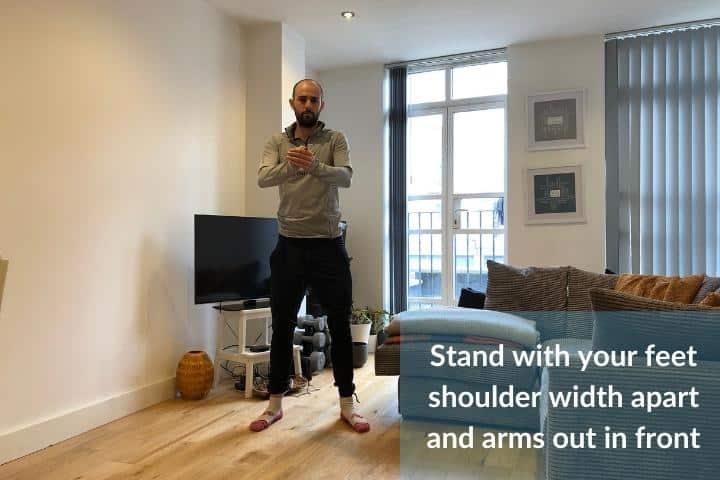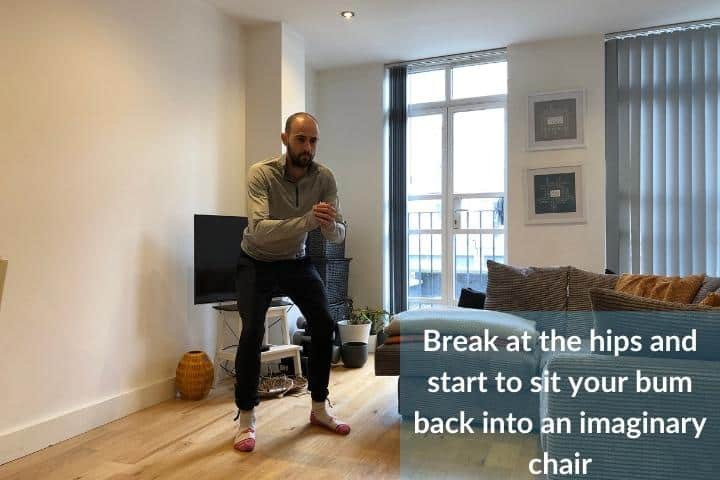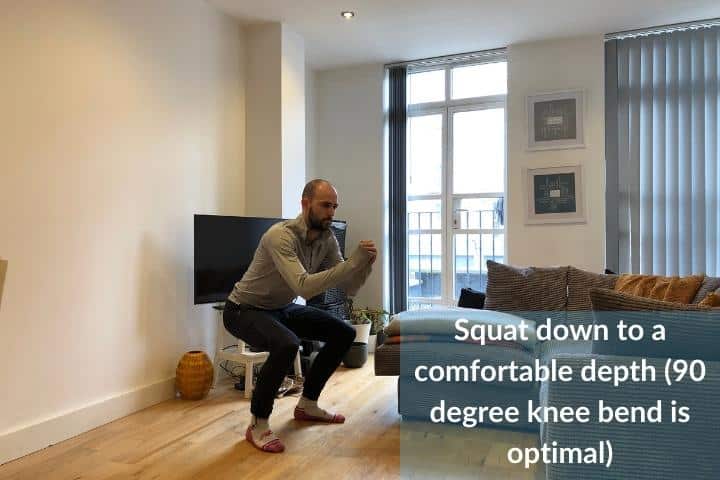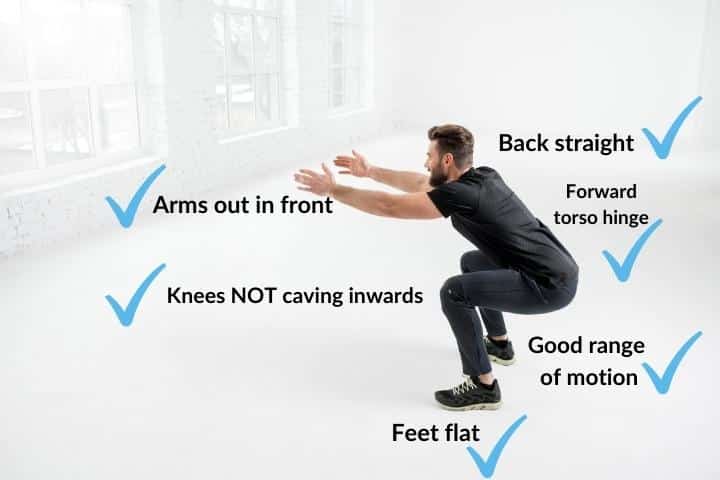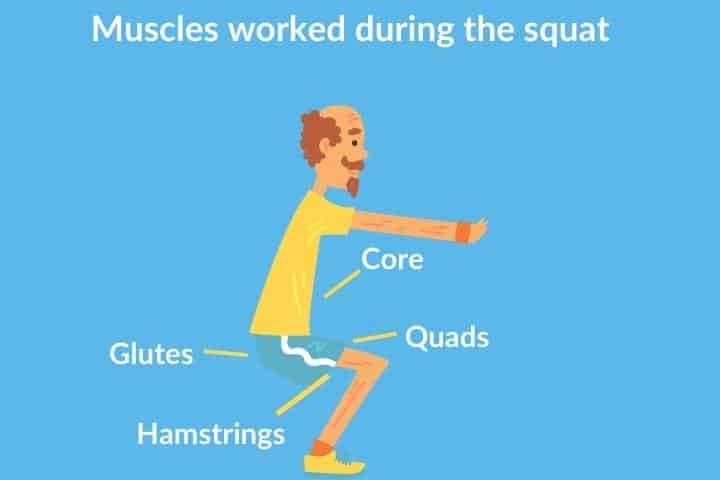Squats for elderly people are a fantastic exercise help preserve and even grow muscle mass and strength in the legs.
Last updated May 2024
This article contains a lot of evidence based information on squats for elderly people. I recommend using the contents table above to find the specific information about squats you are looking for.
Today I'm going to show you exactly how to do squats really well. I'll also show you lots of variations to make them easier for those of you with limited mobility or other issues such as arthritis. I will also explain why squats for elderly are very desirable and will likely have a significantly positive impact on quality of life.
Let's start by watching the below video where I'll go through the squat in detail.
(if you can't see the video click HERE to view on Youtube)
Squats for elderly in steps
Step 1
Step 2
Step 3
Here's a picture demonstrating some good technique points for the squat that I also talked about in the video.
Why is the squat such a great exercise for the elderly and seniors?
The squat is actually a fantastic exercise across all age groups.
For older adults and seniors it's an excellent exercise to help preserve and even grow muscle mass in the legs.
During the movement of the squat all the muscles in the lower body are working (including the core).
Not only that, the squat perfectly simulates the standing to sitting and sitting to standing movement pattern. Think for a second how many times per day you sit down and stand up. Quite a few times!
Building better strength in this particular movement pattern which you use everyday can make a huge difference to your quality of life and increased independence as you age.
In this study, 16 people with an average age of 68 were assigned to either a deep squatting or shallow squatting group. Participants performed four sets of squats per day (35 repetitions per set), three days per week, for 12 weeks at their home. The study results showed that squatting improved strength regardless of the squat depth. It is more likely that the consistency of performing squats combined with making sure enough repetitions are done is the critical factor.
These results perfectly align with the "progressive overload" concept that the Wise Fitness Academy workouts adhere to. Ultimately, muscles have to have an adequate amount of stress placed on them in order to signal to the body to adapt and get stronger.
How many squats should I do as an elderly person or senior?
Our bodies are extremely adaptable. If we don't place any kind of stress on our muscles (including the heart) they won't get any stronger. In fact, the ageing process makes our muscles (including the heart) become weaker overtime.
By doing resistance exercises frequently you signal your body to adapt to become stronger. The amount of stress you place on your muscles is fairly easy to gauge because we can feel it.
If you try and do 100 squats you'll probably feel lots of fatigue and pain in your legs long before you get to 100.
Essentially you should do as many squats as is needed until you feel some level of fatigue in them. That fatigue is an indicator that you are placing stress on your muscles and they will therefore grow and become stronger.
Will bodyweight squats be enough to get stronger and an elderly person?
At first, yes most likely. But remember I said about your body being extremely adaptive? After sometime of doing body weight squats regularly your body will adapt that level of stress and then stop adapting.
You then need to add more stress to force the body to continue to adapt. This is known as progressive overload and its a key component to getting progressively fitter and stronger.
You can add more stress in many ways:
- Adding more reps or more sets.
- Holding onto a weight during the exercise and increasing the weight over time.
- Slowing down or speeding up the tempo of the exercise.
The first and third methods of adding in more stress are great as they are so easy to implement. Wayne Westcott, PHD is a leading authority in strength training for older adults and his research has shown simply slowing down reps can have a signifiant impact on strength gains. He's written about this concept in this article. (he also advocates for squats!)
These are all good examples of adding more stress (progressive overload).
This study looked at 15 older adults who needed help to perform general daily activities and placed them into a 12 week bodyweight squatting programme. It concludes that Group-based body-weight squat exercise in physically frail older adults improves muscle mass and strength.
A really simple programme of just 1 simple exercise can make a huge difference.
Can I do squats/workouts at home?
Absolutely!
Technically you don't need any equipment at all to do squats. However is can be helpful to use a chair for added support.
Anywhere you can sit down and stand up is a good place to do squats.
Squats a such a fundamental movement pattern they are included in the Get Stronger Programme exercise library. You can sign up up for the free programme by clicking here
Chair squats for seniors
As you will have seen in the video, using a chair is a great idea if you are a little nervous about doing squats to start with. Having the chair behind you allows you to sit into it before standing back up again. If the chair has handles you can use them to help support the movement as well. It's win win!
What muscles are worked during the squat?
The squat is an example of a compound exercise meaning 2 or more muscles are being worked at the same time during the exercise.
In the case of the squat:
- the glutes
- the quads
- the hamstrings
are all working during the movement. These 3 muscles account for a huge proportion of lower body musculature. Having all 3 of these muscle groups nice and strong will give you great mobility and confidence.
Are squats bad for seniors and older adults?
The simple answer is no! Squats are NOT bad for older people. On the contrary, they are generally very good for older people to do. As I've already talked about, squats simulate probably the most common movement pattern we do everyday. To say squats are bad is a bit like saying, standing up and sitting down is bad. It's ridiculous!
Squats can be challenging, especially if you are quite frail or have arthritis. However, its fine use modifications and aids to assist with your squatting.
Using the arms of a chair, using sticks or using the back of a chair are all great ways of making squats a little bit easier to do.
It's normal to feel a bit of pain in an arthritic joint when you exercise. Try to adapt the movement to minimise that discomfort you might feel. You can do this by:
- Changing the width if your stance (try setting your legs wider apart)
- Use chair handles to assist with the movement
- Reduce the range of motion (don't squat too deep)
If you want some further information on exercising with arthritis you can read my article "Exercising with arthritis"
Get squatting if you want to build up your strength and muscle mass.
Please don't forget to share this Squats for elderly article if you found it useful. You can click the below link and email it to a friend or relative
Share this article
Author:
Ollie Laver
Founder at Wise Fitness Academy
Qualifications:
Level 3 Personal trainer with Train Fitness
Certified Nutritionist with MNU
Squats for elderly FAQ
The simple answer is no. Squats are not bad for older adults or elderly people.
Why would a squat be "good" for younger people and "bad" for older people? It's absolute nonsense. Sometimes, there might be a better alternative exercise than a squat for certain people depending on things like injuries. Age has not bearing on this at all.
Squats simulate the sitting to standing movement pattern which we all do in everyday life. It makes complete sense to be strong in this movement pattern. To say elderly people shouldn't so squats is the same as saying elderly people shouldn't sit down or stand up!
On an individual basis squatting may not be the best option. For example, someone with advanced knee arthritis where squats cause a big exacerbation of pain. In these cases, there are loads of alternative exercises that you can do.
Start slow and build up your strength.
Absolutely!
There are so many ways you can do squats.
For those with limited strength and mobility do chair squats (simply sit onto a chair and stand back up again) and use the arms to help you up and down if you need to.
As you progress you can simply hold onto the back of chair or table for support as you do squats.
Lots of the Wise Fitness Academy members have progressed onto holding weights during their squats.
They're stronger then ever before!
A mini squat or a partial squat is a great regressed version of a squat that you can do if you limited mobility. You don't need to sit all the way down if you find that too difficult. To start with, try squatting to a comfortable depth and then build up the depth over time. You can also use a prop such sticks or the arms of a chair you are squatting into to help with the depth you are squatting to.
Sources
- Effects of StrongPeople Strong Bodies on Functional Fitness: A Community-Based Randomized Trial; Rebecca A. Seguin-Fowler,1 Michelle Grocke,2,3 Meredith L. Graham,1 Dawn Tarabochia,2 Urshila Sriram,1 and Galen D. Eldridge1.
- Impact of home-based squat training with two-depths on lower limb muscle parameters and physical functional tests in older adults; Akito Yoshikocorresponding and Kohei Watanabe
Influences:
- Wayne Westcott, PHD - A leading authority in strength training for older adults
- Drs. Miriam Nelson - dedicated social entrepreneur working on sustainability, public health, food systems. A leading figure in the promotion of strength training for older women


